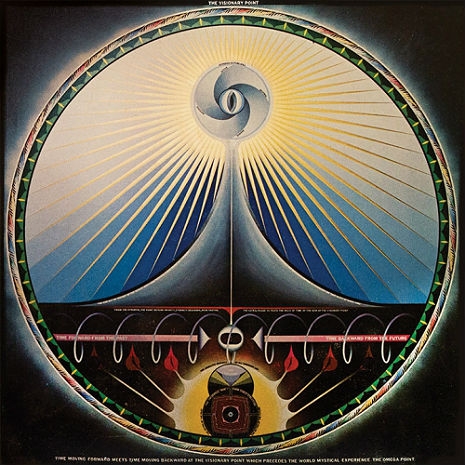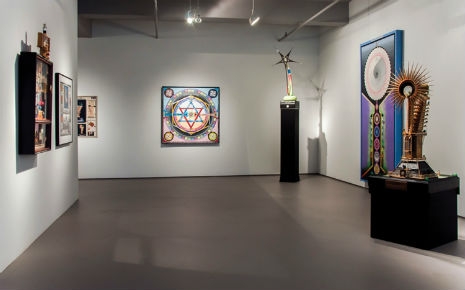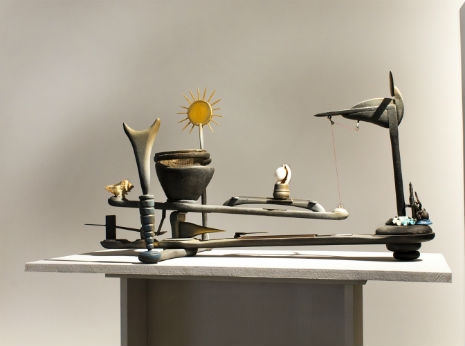
For those of you lucky to be in NYC this month, there’s an especially exciting new Paul Laffoley exhibit opening at Kent Fine Art (210 Eleventh Ave between 24th and 25th) in Chelsea.
“The Force Structure of the Mystical Experience” will provide a rare glimpse at some of Laffoley’s seldom-seen models and sculptures, as well as some early work from the 1960s and a few key paintings not exhibited in recent years. The artist will be present at the gallery on September 10, 11, and 12th.
An online publication for the show was edited by Douglas Walla with detailed notes from Paul Laffoley on each piece. I wrote the intro, which follows. If you would like to look at the entire full-color 132 page PDF catalog, it can be downloaded here.

Penetrating the Kitsch Barrier
How does one approach the work of Paul Laffoley? It’s not really like anything else and doesn’t fit neatly into any easy category that the art world routinely employs. How do you even begin to wrap your head around the vastness of his cosmic vision?
He’s not merely a painter whose work sells for six figures and has been exhibited internationally at some of the world’s best and most forward-thinking museums, or the subject of several books, TV segments, newspaper and magazine articles. He’s also a Harvard-trained architect who has dreamt up living buildings grown from seeds and a bridge connecting the Moon and the Earth. A philosopher. An alchemist. A science fiction-style inventor of a time machine. He speaks Latin, Greek, French, German and several other languages. Laffoley majored in the classics as an undergrad at Brown and is an expert on the most cutting edge and far out worlds of scientific discovery. I think he’s one of the great living geniuses of our time and I know that I’m not alone in that assessment.
Paul once detailed an erudite impromptu dinnertime dissertation on modern engineering by informing me that each and every futuristic invention anticipated by Jules Verne had been realized (submarines, rocket ships, space travel, etc) and that science fiction really stopped being “prophetic” around the mid 20thcentury, with anything a science fiction writer could dream up eventually getting “invented” and put into mass production by a large corporation. (“How closely did the communicators on Star Trek anticipate the flip phone?” he asked.) Scoff if you will at his schematic for a gigantic genetically engineered ectoplasmic jellyfish that allows for communication with not only the dead, but the yet-to-be-born (for the purpose of intergenerational planning which would avert catastrophes), Leonardo’s cronies probably laughed at that crazy thing he sketched out back in the day that resembles our modern-day helicopters. It’s all relative.
Once I described Paul in print as a Bodhisattva reincarnated in the form of a mild-mannered sci fi-loving Boston architect, but years later (although I still see some value in my earlier call) I’d rather ask the reader to imagine what Buckminster Fuller would have done if he were a fine artist in addition to all that other cool stuff he got up to.

THE PSYCHOKENETIC WATER BALANCE: A DEVICE FOR TESTING PSYCHOKENESIS, 1980. Homage to: Isamu Noguchi [1904-1988] and Robert Hare [1781 – 1858]. Oil, acrylic, wood, wire mesh, string, shells and water. Fully hand carved, unique, 18 ½ x 35 x 17 1/2 in. 47 x 89 x 44.5 cm.
This is my favorite Paul Laffoley story and I think it’s particularly revealing about the way his beautiful mind works:
It was late February of 2000. I arrived home at my West Village apartment one evening to find a package waiting for me from Paul containing a most peculiar object, by name, “The Antikitschkitron” a “device for penetrating the kitsch barrier.” It was a small box, handmade, black-painted wood save for the top, which was a clear plastic sheet with a plastic bubble that read “TIME DILATION” in the Helvetica press type Laffoley is known for using. Inside were all sorts of light-emitting diodes, circuitry, electronic capacitors and exposed wiring—in other words, the machine’s guts were plainly visible and a coil of copper wire coming out the top with a circular sun-like ornament affixed to it like exposed bicycle tire spokes. It seemed like something that might transmit a “beam” of an electronic or cosmic nature.
The device, which resembled some sort of curious text-covered mutant dowsing machine, or a Star Trek version of one of Joseph Cornell’s boxes crossed with a metal detector. On the top was a big red clunky on/off switch.
Thrilled by this incredible gift, I immediately picked up the phone and dialed Paul in Boston. The ritual when calling him is that he screens all of his calls. The voice on the outgoing message is not Paul’s, and the caller is informed that he or she have reached the Boston Visionary Cell and to please leave a message after the beep—a drill developed when avoiding credit card collection agencies as he once humorously admitted to me. I started to leave a message, Paul picked up right away and I started gushing my gratitude about the amazingly weird—and absolutely beautiful—object/device that I was holding in my hand. What a thrillingly strange thing to get in the mail, I’m sure you’ll agree, but at this point I noticed that there was no obvious power source.
“Where do you put the battery?” I innocently inquired.
“Oh, there’s no battery,” he said with his strong, slightly stuttering Bostonian accent. “You know my concept of the… a… the uh.. luxe theater of the mind? Well it’s like that. You have to interact with the device and connect the circuitry to your mind, um, uh, in that way.”
I paused for a moment before mentally recalibrating and moving myself as much as possible into Paul’s philosophical framework before (I thought) redeeming myself with “Okay, so it’s like like Yoko Ono’s “Box of Smile” where you open it up, you see that there is a mirror inside and invariably everyone who interacts with the piece smiles, right?”
“Well, yes…” he said slowly, indicating a “yes” that was about to be uniquely qualified, “...but with my device, you have to actually turn it on.”

The Essential Paul Laffoley: Works from the Boston Visionary Cell, an oversized, comprehensive, annotated catalogue raisonné edited by Laffoley’s longtime friend and gallerist Douglas Walla, with several essays by the artist and others, will be published by the University of Chicago Press in Spring 2016. I have a B&W print-out of the book and it’s one of the most exciting and stunning art books I’ve ever seen. Mark my words, it’ll be a cultural event when this book comes out. It’s TIME for it.